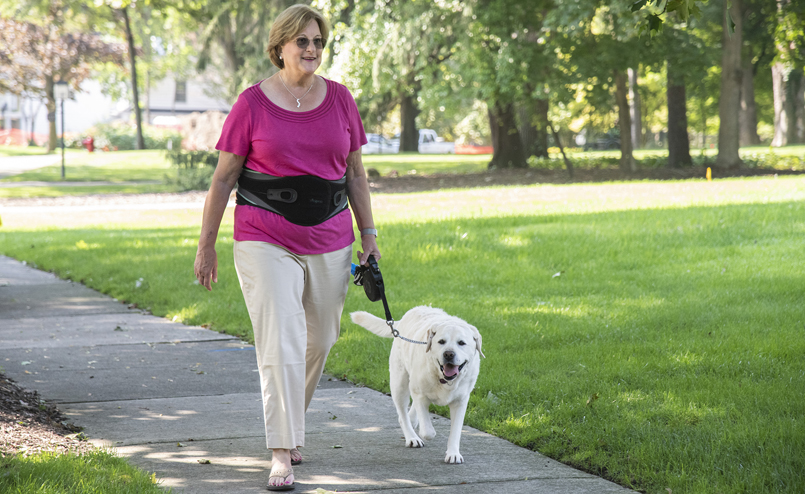Wednesday, October 09, 2019

Michigan woman benefits from surgical robotic guidance system
When Lynn Groth’s doctor told her she needed spinal fusion surgery, she was so shocked and surprised, she got three other opinions.
Groth, of Bloomfield Hills, is no stranger to back pain. Fifteen years ago, she had back surgery for a disc problem. And then last fall, it returned – lower back pain, along with pain which traveled down one leg. In her other leg, she experienced numbness.
But this time, for Groth, now 63, it was more than a herniated disc. Dr. Fernando Diaz, spine specialist and director, Neurosurgery, Beaumont Hospital, Royal Oak, identified her sources of back pain – stenosis and degenerative scoliosis. His recommendation: spinal fusion surgery. Three other doctors supported Dr. Diaz’s assessment.
“I was disappointed all the doctors agreed and recommended spinal fusion,” said Groth.
She feared a long and painful recovery. Along with those concerns, she and her recently retired husband had made plans for a trip to Asia in early 2020.
Complex diagnosis
Dr. Diaz told Groth she had degenerative disc disease – causing her spine to go out of alignment. His diagnosis: degenerative scoliosis – a curvature in her spine caused by a degeneration of discs and joints. He also observed a narrowing in her spinal canal. This condition is known as spinal stenosis.
The spinal canal contains nerve roots and the spinal cord. Spinal fusion can help improve both conditions by fusing two vertebrae together with a bone graft. The two then heal into a single, solid bone. Spinal fusion is a surgical procedure that stabilizes the spine.
According to Dr. Diaz, without surgical intervention, someone like Groth would gradually experience more pain and numbness. This could eventually lead to needing a wheelchair.
In the 15 years since Groth’s last back surgery, new robotic technology has made procedures like spinal fusion less invasive, more precise, faster and safer.
Robotic guidance system
Dr. Diaz is part of a team of spine surgeons at Beaumont Hospital, Royal Oak trained to use a robotic guidance system called the Mazor X. This navigation technology assists surgeons to ensure precise placement of instruments in the spine. Each surgery is planned on a computer. Before surgery, patients get a spinal CT scan. Based on the scan, the system’s software maps the spine. The advanced planning benefits both the surgeon and the patient in the OR with:
- a reduction in operating time.
- less tissue damage.
- a reduction in radiation exposure.
- fewer infections, a reduction in potential complications.
Beaumont surgeons have done about 100 cases using this robotic guidance system.
2-step process
Based on Groth’s diagnoses, Dr. Diaz explained two surgeries were needed to address her back issues, “The goal of the surgeries was to correct Lynn’s curvature changes and then stabilize her spine.”
During her first surgery on May 21, Dr. Diaz inserted spacers between her vertebras to create realignment. This restored the curvature of her spine and released nerves. After Groth’s surgery, she experienced relief.
“The pain and numbness in my legs was gone,” she said. “I felt so good, I wondered if I needed a second surgery.” Dr. Diaz assured her more needed to be done, and for the second surgery he used the robotic guidance system.
Two days later, Dr. Diaz removed some of Groth’s spinal bones. The bones were ground down and used again to form new bone to fuse two vertebrae. The robotic navigation system pinpointed where titanium screws were inserted to stabilize her spine.
Postop/Recovery
Now, four months since her surgeries, Groth’s recovery is going well. “I feel great. It’s amazing to have little to no pain.”

Post-op, Dr. Diaz and his team told her:
- not to bend over or twist.
- not to lift anything heavier than 5 pounds.
- wear her back brace.
- to walk, walk, walk and add 1 minute per day.
“I started walking for 12 minutes and was told when I could walk for an hour, I could resume driving,” said Groth. “I began driving about 6 weeks later.”
Along with walking, she has added swimming.
The lack of any major discomfort has been a pleasant surprise for Groth, “I expected more pain and numbness during my recovery. I’ve not taken as much pain medication as I anticipated.”
Dr. Diaz said Lynn’s future looks good. While healing time for spinal fusion depends on a patient’s age, it usually takes 6-12 months before they can return to most activities.
Groth is looking forward to visiting Asia in January.
